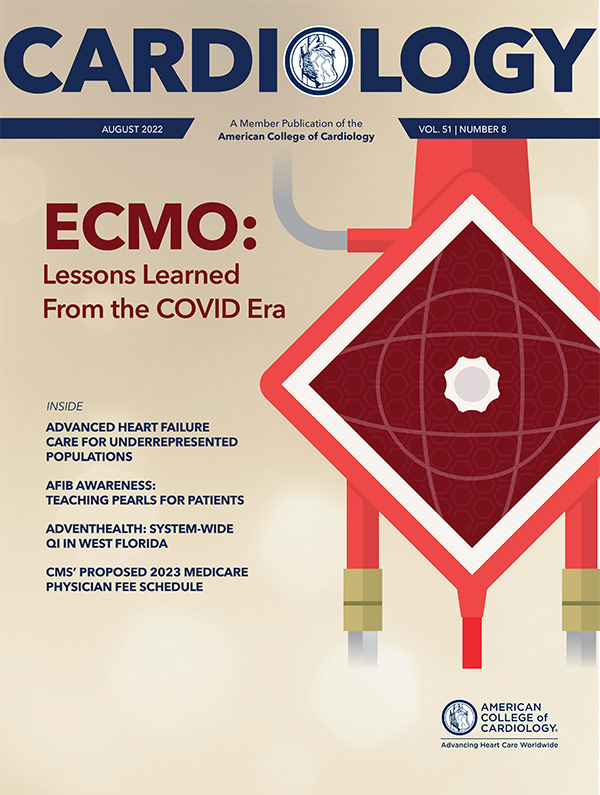Feature | SCCT Expert Consensus Document on CAD Reporting
The Society of Cardiovascular Computed Tomography (SCCT), in collaboration with the ACC, the American College of Radiology and the North America Society of Cardiovascular Imaging, has published a new expert consensus document on Coronary Artery Disease – Reporting and Data System (CAD-RADS™ 2.0) aimed at standardizing the reporting system for patients undergoing coronary CT angiography (CCTA) and guiding possible next steps in patient management.
The document, led by Ricardo C. Cury, MD, MBA, FACC, and Ron Blankstein, MD, FACC, updates and expands on the first version created in 2016 based on the latest technical developments and recent clinical trials and guidelines in CCTA. The statement outlines an established framework of stenosis, plaque burden and modifiers, and includes assessment of CT fractional-flow-reserve (CT-FFR) or myocardial CT perfusion (CTP), when performed.
Even though coronary CTA can be a very useful test when performed on the right patient population, the test itself does not change outcomes. Rather, it is how clinicians act on the test results that ultimately makes a difference. For this reason, it is essential to provide referring clinicians with patient management recommendations which are now part of the CAD-RADSTM 2.0 statement.
– Ron Blankstein, MD, FACC
Highlights from the CAD-RADSTM 2.0 statement include a recommendation to estimate plaque burden whenever present, using either an evaluation of the amount of coronary artery calcium (CAC), segment involvement score (SIS), a visual assessment, or total plaque burden quantification, when available and validated. Based on these methods, the overall amount of plaque (P) descriptor ranges from P1 to P4 (mild, moderate, severe, extensive) to denote increasing categories of plaque burden.
The statement also includes the addition of two new modifiers: 1) Modifier I (ischemia) indicating that an ischemia test with CT has been performed (either CT-FFR or stress CTP) and if the result was positive (+), negative (-) or borderline (+/-); and 2) Modifier E (exceptions) to denote the presence of non-atherosclerotic narrowing of the coronary arteries.
Along with these and other updates, the authors note that some consistencies remain from the original guideline and are emphasized in the 2.0 version, including the stenosis severity classification, ranging from CAD-RADS 0 for absence of any plaque or stenosis to CAD-RADS 5 indicating the presence of at least one 100% occluded vessel. The authors also stress that CAD-RADSTM classification should always be interpreted together with the impression found in the report.
"Even though coronary CTA can be a very useful test when performed on the right patient population, the test itself does not change outcomes. Rather, it is how clinicians act on the test results that ultimately makes a difference. For this reason, it is essential to provide referring clinicians with patient management recommendations which are now part of the CAD-RADSTM 2.0 statement," says Blankstein.
In addition to supporting clinicians with patient management, Cury also notes that the updated document has the added continued benefit of offering a standardized framework to support education, research, peer review, artificial intelligence development, clinical trial design, population health and quality assurance into the future.
In terms of outcome data, the framework can assist data collection across subcategories, such as the follow-up of patients based on CCTA results, rate of downstream testing, correlation with invasive coronary angiography, rate of coronary revascularization including PCI and CABG, and major adverse cardia events including cardiovascular death and myocardial infarct.
Along with clearer communication of imaging results among all the members of the clinical care team, the authors note that standardizing reports and management recommendations will enhance communication between imagers, providers, researchers and computer-based systems. "This may facilitate the development of decision support technologies and serve as the basis for developing artificial intelligence and natural language processing algorithms."
Clinical Topics: Cardiac Surgery, Cardiovascular Care Team, Invasive Cardiovascular Angiography and Intervention, Noninvasive Imaging, Atherosclerotic Disease (CAD/PAD), Aortic Surgery, Statins, Interventions and Coronary Artery Disease, Interventions and Imaging, Angiography, Computed Tomography, Nuclear Imaging
Keywords: ACC Publications, Cardiology Magazine, Coronary Angiography, Coronary Artery Disease, Computed Tomography Angiography, Cytidine Triphosphate, Fractional Flow Reserve, Myocardial, Follow-Up Studies, Consensus, Calcium, Artificial Intelligence, Constriction, Pathologic, Natural Language Processing, Peer Review, Research, Data Systems, Percutaneous Coronary Intervention, Cardia, Myocardial Infarction, Data Collection, Radiology, Patient Care Team, Population Health, Perfusion, Ischemia, Coronary Artery Bypass
< Back to Listings

